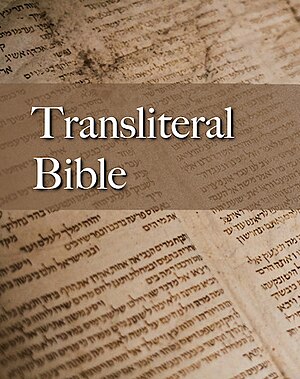Transliteral Bible
Script error: No such module "Draft topics". Script error: No such module "AfC topic".
| Transliteral Bible | |
|---|---|
 | |
| Full name | Transliteral Bible: New Testament |
| Abbreviation | TRLIT |
| Language | English |
| NT published | 2024 |
| Authorship | Oliver Tseng |
| Textual basis | KJV |
| Translation type | English Transliteration |
| Reading level | High School |
| Copyright | © 2024 by Oliver Tseng. Released under Apache License 2.0 |
| Website | transliteralbible |
Re'shiyth 'Elohiym bara' the shamayim and the 'erets. And the 'erets was tohuw, and bohuw; and choshek upon the paniym of the tĕhowm. And the ruwach of 'Elohiym rachaph upon the paniym of the mayim. And 'Elohiym 'āmar, Let there be 'owr: and there was 'owr.
For theos so agapaō the kosmos, that he didōmi his monogenēs huios, that whosoever pisteuō in him should not apollymi, but have aiōnios zōē. | |
The Transliteral Bible (TRLIT) is an English translation of the Bible that transliterates key words in the King James Version text. It allows readers to be able to read the Bible in a format closer to the original languages.
Purpose of the Transliteral Bible[edit]
- To read the Bible in the original languages without the need to learn the Hebrew and Greek alphabets and grammar.
- To assist in learning Hebrew and Greek by focusing first on vocabulary instead of grammar.
- To read in a closer format to how the Bible was originally written.
- To have a deeper and richer understanding of the Bible.
Translation Methodology[edit]
The translation methodology takes the King James Version text and replaces English words that have a Strong's number through the process of transliteration. For example, the Greek word for God “θεός” is transliterated to “theos”. Most nouns, verbs, and adjectives are transliterated. Words in italics are also removed.
Since the methodology used is a mechanical process, no interpretation bias is introduced. Anybody who uses this methodology would achieve practically the same result, even if they do not know the original languages.
Since the Transliteral Bible is not hampered by having to decide how to translate words into English, there is no dynamic equivalence versus formal equivalence problem involved. Instead of a translator interpreting the meaning of the original words, it pushes the responsibility of interpreting what the original words mean to the reader.
Limitations of the Transliteral Bible[edit]
- The Transliteral Bible is intended to be a study Bible and is not meant to be a natural reading Bible.
- Only the base Greek/Hebrew words are used for transliterated words, so it strips the words of grammatical information (number, case, tense, voice, mood).
- This translation is not intended to replace any Hebrew or Greek critical text. The ultimate way to read the Bible would be to read it in the original languages.
Strong's and Lexicon[edit]
All transliterated words include the Strong's number. In the Kindle version, Strong's numbers are linked to the lexicon at the back of the book.
Translation status[edit]
The New Testament was published on January 2024. The Old Testament is currently being translated.
External links[edit]
This article "Transliteral Bible" is from Wikipedia. The list of its authors can be seen in its historical and/or the page Edithistory:Transliteral Bible. Articles copied from Draft Namespace on Wikipedia could be seen on the Draft Namespace of Wikipedia and not main one.
